Council for Better Leaders
Download as pptx, pdf0 likes259 views
Aanpak, blauwdruk en basis voor creatie van een andere samenleving en samenwerking tussen burgers. Contact: mindflowingprojects@gmail.com
1 of 22
Download to read offline


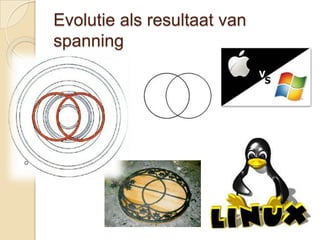
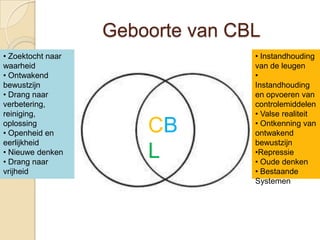

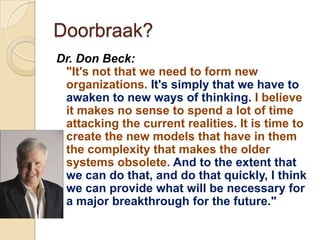

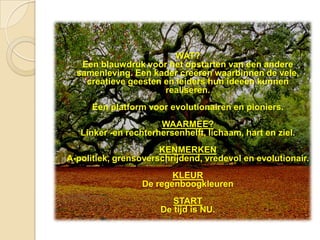
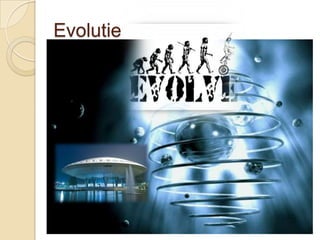
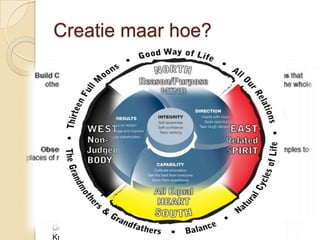
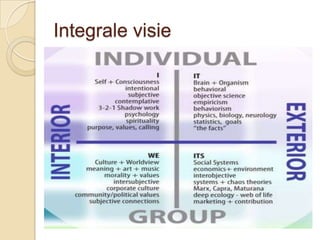
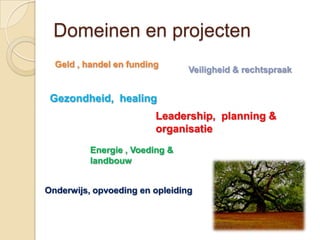



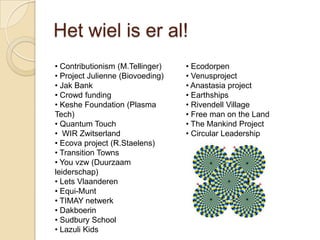






Ad
Recommended
Bizzwise Bootcamp 2013 Jan Bommerez
Bizzwise Bootcamp 2013 Jan BommerezEffect E-Business
╠²
Laat je Inspireren door Jan_Bommerez @ Bizzwise Bootcamp 2013
Disruptive Technology :
Vergeet de moeilijkheden en kijk naar de mogelijkheden
www.bizzwise.nlTom Kniesmeijer - Deuren openen waar anderen muren zien
Tom Kniesmeijer - Deuren openen waar anderen muren zienINK Utrecht
╠²
Bijdrage van Tom Kniesmeijer op het INK-najaarssymposium 2012Inspiratievoorprogrammerendebibliothecarissen
InspiratievoorprogrammerendebibliothecarissenHans van Duijnhoven
╠²
Tendenzen in onze samenleving: G1000 Uden, rol van de bibliotheek, Susan Neiman's Waarom zou je volwassen worden?, Wim de Ridder, Rutger Bregman, Het boek der waarden, Seth Godin en de noodzaak dat volwassenen zich (weer) meer als volwassenen gaan gedragen en in dat verband idee├½n of een vergezicht voor een andere (betere) samenleving gaan formuleren ├®n proberen na te streven. Weg van het redelijk adolescente gedrag dat zich kenmerkt door cynisme, afgeven op anderen en vooral'niet opbouwend' bezig zijn.ELLLA presentatie Jan Bommerez 21 maart 2011
ELLLA presentatie Jan Bommerez 21 maart 2011ELLLA
╠²
Presentatie Jan Bommerez 'De ideeeneconomie en het nieuwe werken', masteravond ELLLA Steenwijkerland 21 maart 2011Presentatie Jan Bommerez 18 Maart 2009
Presentatie Jan Bommerez 18 Maart 2009ELLLA
╠²
De presentatie gaf Jan Bommerez tijdens de 1e module van de Top Leergang Leiderschapsontwikkeling 2009 van ELLLA.Kennissessie Social Media UU
Kennissessie Social Media UUInge_Beckers
╠²
28 feb 2012: kennissessie op de Universiteit Utrecht over aspecten bij de implementatie van social media - Het is een nieuwe manier van werken en lerenThermal recovery
Thermal recoveryfidans47
╠²
This document references sources for calculations and examples related to thermal recovery methods. It cites chapters and examples from specific texts on steam drive processes, thermal recovery of oil and bitumen, and analytical modeling of heavy oil recovery from cyclic steam in pressure-depleted reservoirs. The numerical example is taken from a chapter on thermal recovery in one of the referenced texts.Steam Flooding
Steam FloodingGowtham Dada
╠²
Steam flooding is a method used to improve heavy oil recovery after waterflooding. There are two main types: cyclic steam stimulation which uses a single well for injection and production over cycles, and steam flooding which continuously injects steam into multiple injection wells to drive mobilized oil towards producers. As steam is injected, it forms distinct zones - a condensing zone, saturated steam zone, transition zone, and displacement zone. Heat from steam reduces oil viscosity and interfacial tension, altering wettability and improving displacement of oil towards producers. Optimal recovery involves infill drilling, waterflooding after breakthrough, using low quality steam, and foaming additives to reduce gravity override.Cyclic Steam Injection
Cyclic Steam InjectionJohn978010
╠²
The document discusses CSS (cyclic steam stimulation) technology for heavy oil recovery. It describes the CSS mechanism and main production process, which involves injecting steam to reduce oil viscosity and increase mobility. It then outlines some key mature CSS technologies, including high-efficiency steam injection systems using vacuum insulated tubing and thermal packers, as well as downhole measurement techniques. Finally, it provides selection standards for reservoirs suitable for successful CSS projects.Enhanced oil recovery using steam
Enhanced oil recovery using steamNoaman Ahmed
╠²
The document discusses enhanced oil recovery (EOR) methods, focusing on steam injection. It defines EOR as techniques for extracting more crude oil from reservoirs beyond primary and secondary recovery methods. Steam injection is a thermal EOR method that involves injecting steam into reservoirs to lower oil viscosity and produce more oil. There are two main steam injection techniques - cyclic steam stimulation (also called huff-and-puff) which alternates between steam injection and production from single or multiple wells, and steam flooding which continuously injects steam into reservoirs to displace oil towards production wells. The document outlines some advantages and disadvantages of steam injection and economic considerations.Q921 rfp lec5
Q921 rfp lec5AFATous
╠²
This document provides an overview of methods for calculating key gas properties including:
1. The z-factor, which can be calculated using correlations like Hall-Yarborough or Dranchuk-Abu-Kassem that were developed based on the Standing-Katz chart.
2. Isothermal gas compressibility (Cg), which can be determined from the z-factor or using models that relate it to reduced gas density.
3. Gas formation volume factor (Bg) and gas expansion factor (Eg), which relate the volume of gas at reservoir conditions to standard conditions.
4. Gas viscosity, which can be estimated using correlations like Carr-Kobayashi-Burrows that are functions ofEnhanced oil recovery
Enhanced oil recoveryHimpunan Mahasiswa Teknik Kimia Universitas Diponegoro 2011
╠²
This document discusses enhanced oil recovery (EOR) methods that can be used to extract additional oil from reservoirs when traditional production methods become inefficient. It outlines three main EOR techniques: chemical injection, miscible displacement, and thermal recovery. Chemical and miscible displacement methods involve injecting gases or chemicals to mobilize remaining oil, while thermal recovery uses steam injection to reduce oil viscosity in heavy oil reservoirs. The overall goal of EOR is to maximize the amount of oil recovered from each reservoir or well.Eor 1 introduction
Eor 1 introductionAktham Ehab
╠²
This document discusses enhanced oil recovery (EOR) techniques used to extract crude oil beyond primary and secondary recovery methods. It defines EOR as any process that improves oil recovery beyond what conventional methods would produce. EOR techniques are divided into four categories: miscible flooding processes, chemical flooding processes, thermal flooding processes, and microbial flooding processes. Thermal processes are generally used for heavy oils while chemical and miscible processes target lighter oils. The document also outlines key recovery factors and terminology used in EOR like displacement efficiency, sweep efficiency, and mobility ratio.Oil and Gas Reservoir Engineering
Oil and Gas Reservoir EngineeringKhawar Nehal khawar.nehal@atrc.net.pk
╠²
This document provides information about reservoir engineering. It discusses how reservoir engineers use tools like subsurface geology, mathematics, and physics/chemistry to understand fluid behavior in reservoirs. It also describes different well classes used for injection/extraction, environmental impacts of enhanced oil recovery, and various reservoir engineering techniques like simulation modeling, production surveillance, and evaluating volumetric sweep efficiency. Thermal and chemical enhanced oil recovery methods are explained, including gas, steam, polymer, surfactant, microbial and in-situ combustion injection.OIL RECOVERY TECHNIQUES
OIL RECOVERY TECHNIQUESGerikaran Patel
╠²
The document summarizes various methods for oil recovery from reservoirs, including primary, secondary, and tertiary (enhanced) recovery. Primary recovery uses the natural reservoir pressure to extract about 20% of oil. Secondary methods like water flooding can recover 25-35% of oil by increasing reservoir pressure. Tertiary recovery methods apply additional techniques like steam injection or microbial injection to reduce viscosity and extract further oil, recovering up to 50-60% of the total. The document provides details on different secondary and tertiary techniques used to maximize oil recovery from reservoirs.Petroleum production engineering
Petroleum production engineeringMaanik Gupta
╠²
This document provides a preface and overview for a textbook on petroleum production engineering. It discusses how modern computer technologies have revolutionized the petroleum industry and motivated the authors to write this textbook. The textbook is intended to provide production engineers with guidelines for designing, analyzing, and optimizing petroleum production systems using computer-assisted approaches. It covers topics like well performance, artificial lift methods, and production enhancement techniques across 18 chapters in 4 parts. The preface provides details on the intended audience, topics covered, and goals of presenting engineering principles through examples and companion computer programs.Life Cycle of Oil & Gas Wells
Life Cycle of Oil & Gas WellsMohamed Elnagar
╠²
The document outlines the life cycle of oil and gas wells, including planning, drilling, completion, production, and abandonment phases. It describes the planning process including well classification and formation pressure considerations. Key aspects of drilling are discussed such as rig types, crews, casing, and use of drilling mud to remove cuttings from the wellbore.Oil & Gas Production and Surface Facilities
Oil & Gas Production and Surface FacilitiesMohamed Elnagar
╠²
The document discusses oil and gas production and surface facilities. It begins with an introduction to the upstream, midstream, and downstream sectors of the oil and gas industry. It then covers well types at the production phase, including oil, gas, and water injection wells. It describes key wellhead components like the casing head, tubing head, Christmas tree, and safety control subsurface safety valve. It provides details on various artificial lift methods and their relative advantages and disadvantages. It concludes with descriptions of hook-up and flow line components used to transport oil and gas from wells.Bindboek presentatie8
Bindboek presentatie8Boekanier Bindboek
╠²
Alle tot en met februari 2011 verschenen bladen van BindboekT Ao B 28 Juli 2009 Inclusief Tariefstelling
T Ao B 28 Juli 2009 Inclusief Tariefstellingguest421c54
╠²
Creatiespiraal CENS methode (M. Knoope)
Organis learning trajectgedreven aanpakMore Related Content
Viewers also liked (12)
Thermal recovery
Thermal recoveryfidans47
╠²
This document references sources for calculations and examples related to thermal recovery methods. It cites chapters and examples from specific texts on steam drive processes, thermal recovery of oil and bitumen, and analytical modeling of heavy oil recovery from cyclic steam in pressure-depleted reservoirs. The numerical example is taken from a chapter on thermal recovery in one of the referenced texts.Steam Flooding
Steam FloodingGowtham Dada
╠²
Steam flooding is a method used to improve heavy oil recovery after waterflooding. There are two main types: cyclic steam stimulation which uses a single well for injection and production over cycles, and steam flooding which continuously injects steam into multiple injection wells to drive mobilized oil towards producers. As steam is injected, it forms distinct zones - a condensing zone, saturated steam zone, transition zone, and displacement zone. Heat from steam reduces oil viscosity and interfacial tension, altering wettability and improving displacement of oil towards producers. Optimal recovery involves infill drilling, waterflooding after breakthrough, using low quality steam, and foaming additives to reduce gravity override.Cyclic Steam Injection
Cyclic Steam InjectionJohn978010
╠²
The document discusses CSS (cyclic steam stimulation) technology for heavy oil recovery. It describes the CSS mechanism and main production process, which involves injecting steam to reduce oil viscosity and increase mobility. It then outlines some key mature CSS technologies, including high-efficiency steam injection systems using vacuum insulated tubing and thermal packers, as well as downhole measurement techniques. Finally, it provides selection standards for reservoirs suitable for successful CSS projects.Enhanced oil recovery using steam
Enhanced oil recovery using steamNoaman Ahmed
╠²
The document discusses enhanced oil recovery (EOR) methods, focusing on steam injection. It defines EOR as techniques for extracting more crude oil from reservoirs beyond primary and secondary recovery methods. Steam injection is a thermal EOR method that involves injecting steam into reservoirs to lower oil viscosity and produce more oil. There are two main steam injection techniques - cyclic steam stimulation (also called huff-and-puff) which alternates between steam injection and production from single or multiple wells, and steam flooding which continuously injects steam into reservoirs to displace oil towards production wells. The document outlines some advantages and disadvantages of steam injection and economic considerations.Q921 rfp lec5
Q921 rfp lec5AFATous
╠²
This document provides an overview of methods for calculating key gas properties including:
1. The z-factor, which can be calculated using correlations like Hall-Yarborough or Dranchuk-Abu-Kassem that were developed based on the Standing-Katz chart.
2. Isothermal gas compressibility (Cg), which can be determined from the z-factor or using models that relate it to reduced gas density.
3. Gas formation volume factor (Bg) and gas expansion factor (Eg), which relate the volume of gas at reservoir conditions to standard conditions.
4. Gas viscosity, which can be estimated using correlations like Carr-Kobayashi-Burrows that are functions ofEnhanced oil recovery
Enhanced oil recoveryHimpunan Mahasiswa Teknik Kimia Universitas Diponegoro 2011
╠²
This document discusses enhanced oil recovery (EOR) methods that can be used to extract additional oil from reservoirs when traditional production methods become inefficient. It outlines three main EOR techniques: chemical injection, miscible displacement, and thermal recovery. Chemical and miscible displacement methods involve injecting gases or chemicals to mobilize remaining oil, while thermal recovery uses steam injection to reduce oil viscosity in heavy oil reservoirs. The overall goal of EOR is to maximize the amount of oil recovered from each reservoir or well.Eor 1 introduction
Eor 1 introductionAktham Ehab
╠²
This document discusses enhanced oil recovery (EOR) techniques used to extract crude oil beyond primary and secondary recovery methods. It defines EOR as any process that improves oil recovery beyond what conventional methods would produce. EOR techniques are divided into four categories: miscible flooding processes, chemical flooding processes, thermal flooding processes, and microbial flooding processes. Thermal processes are generally used for heavy oils while chemical and miscible processes target lighter oils. The document also outlines key recovery factors and terminology used in EOR like displacement efficiency, sweep efficiency, and mobility ratio.Oil and Gas Reservoir Engineering
Oil and Gas Reservoir EngineeringKhawar Nehal khawar.nehal@atrc.net.pk
╠²
This document provides information about reservoir engineering. It discusses how reservoir engineers use tools like subsurface geology, mathematics, and physics/chemistry to understand fluid behavior in reservoirs. It also describes different well classes used for injection/extraction, environmental impacts of enhanced oil recovery, and various reservoir engineering techniques like simulation modeling, production surveillance, and evaluating volumetric sweep efficiency. Thermal and chemical enhanced oil recovery methods are explained, including gas, steam, polymer, surfactant, microbial and in-situ combustion injection.OIL RECOVERY TECHNIQUES
OIL RECOVERY TECHNIQUESGerikaran Patel
╠²
The document summarizes various methods for oil recovery from reservoirs, including primary, secondary, and tertiary (enhanced) recovery. Primary recovery uses the natural reservoir pressure to extract about 20% of oil. Secondary methods like water flooding can recover 25-35% of oil by increasing reservoir pressure. Tertiary recovery methods apply additional techniques like steam injection or microbial injection to reduce viscosity and extract further oil, recovering up to 50-60% of the total. The document provides details on different secondary and tertiary techniques used to maximize oil recovery from reservoirs.Petroleum production engineering
Petroleum production engineeringMaanik Gupta
╠²
This document provides a preface and overview for a textbook on petroleum production engineering. It discusses how modern computer technologies have revolutionized the petroleum industry and motivated the authors to write this textbook. The textbook is intended to provide production engineers with guidelines for designing, analyzing, and optimizing petroleum production systems using computer-assisted approaches. It covers topics like well performance, artificial lift methods, and production enhancement techniques across 18 chapters in 4 parts. The preface provides details on the intended audience, topics covered, and goals of presenting engineering principles through examples and companion computer programs.Life Cycle of Oil & Gas Wells
Life Cycle of Oil & Gas WellsMohamed Elnagar
╠²
The document outlines the life cycle of oil and gas wells, including planning, drilling, completion, production, and abandonment phases. It describes the planning process including well classification and formation pressure considerations. Key aspects of drilling are discussed such as rig types, crews, casing, and use of drilling mud to remove cuttings from the wellbore.Oil & Gas Production and Surface Facilities
Oil & Gas Production and Surface FacilitiesMohamed Elnagar
╠²
The document discusses oil and gas production and surface facilities. It begins with an introduction to the upstream, midstream, and downstream sectors of the oil and gas industry. It then covers well types at the production phase, including oil, gas, and water injection wells. It describes key wellhead components like the casing head, tubing head, Christmas tree, and safety control subsurface safety valve. It provides details on various artificial lift methods and their relative advantages and disadvantages. It concludes with descriptions of hook-up and flow line components used to transport oil and gas from wells.Similar to Council for Better Leaders (20)
Bindboek presentatie8
Bindboek presentatie8Boekanier Bindboek
╠²
Alle tot en met februari 2011 verschenen bladen van BindboekT Ao B 28 Juli 2009 Inclusief Tariefstelling
T Ao B 28 Juli 2009 Inclusief Tariefstellingguest421c54
╠²
Creatiespiraal CENS methode (M. Knoope)
Organis learning trajectgedreven aanpakBindboek presentatie10
Bindboek presentatie10Boekanier Bindboek
╠²
Alle bladen van Bindboek tot en met april 2011, inclusief DOORZICHTDe reis van de pionier 3nov2011 online
De reis van de pionier 3nov2011 onlineMirror Wise
╠²
Presentatie Olga Plokhooij Energiedag MKB Krachtcentrale 2011Olga Plokhooij: De reis van de pionier
Olga Plokhooij: De reis van de pionierRijnbeek
╠²
Presentatie van Olga Plokhooij van de Energiedag van de MKB Krachtcentrale op 3 november 2011, georganiseerd door Syntens.T Ao B 28 Juli 2009 Inclusief Synopsis En Tariefstelling
T Ao B 28 Juli 2009 Inclusief Synopsis En Tariefstellingguest421c54
╠²
Creatiespiraal CENS methode (M. Knoope) Organic learning Trajectgedreven aanpakAnders Kijken naar Anders Denken: Op naar een participatiesamenleving via onz...
Anders Kijken naar Anders Denken: Op naar een participatiesamenleving via onz...Frisse Blik Advies
╠²
OP WEG NAAR EEN PARTICIPATIESAMENLEVING
VIA NEURODIVERSITEIT INCLUSIE SOCIALE INNOVATIE
We zijn op weg om van tijdperk te veranderen. Oude structuren voldoen niet langer. Alle door de mens gemaakte systemen zijn al lang over hun uiterste houdbaarheidsdatum heen.
In deze presentatie reik ik u het resultaat van jarenlang ploeteren, netwerken en voltijds denkwerk aan. Dit leverde niet alleen een bondige analyse op van wat er in de kern verkeerd is gegaan (een inzicht wat inmiddels overlapt met vele andere denkers) maar ├│├│k een totaal nieuwe oplossingsrichting die nog niemand ter wereld op deze manier heeft verwoord en verbeeld.
Voor zover ik op dit moment kan nagaan is dit de enige denkrichting die zowel ├®lk mens dichter bij zijn ware natuur kan krijgen als dat ze ├Īlle door de mens gemaakte systemen van kleur kan laten veranderen en mensvriendelijker maken.
Ik kom bij deze met nieuwe woorden, nieuwe beelden, een nieuw domein en zelfs een nieuw mensbeeld.
Dit allemaal in de hoop dat wij onszelf en ons collectieve zelf opnieuw kunnen gaan framen. Ik hoop dat ik u in deze presentatie kan overtuigen van de onmetelijke waarde die het kijken via de lens van onze neurodiversiteit met zich meebrengt.
Het omarmen van het concept van onze neurodiversiteit zou wel eens net zo belangrijk voor het overleven van de mens en de door hem geschapen systemen kunnen zijn als biodiversiteit reeds is gebleken voor de instandhouding ŌĆō en revitalisering - van ecosystemen.
Uitsluiting van dit concept is m.i. een doodlopende weg.
Naast deze presentatie heb ik nog veel meer beelden van hoe we hier daadwerkelijk en grootschalig werk van kunnen maken.
In de hoop dat ik u hiermee van dienst kan zijn.
Met vriendelijke groet,
Helmer van Weelderen
Neuronoom - Spreker - Blogger - Mentor - Personal Branding
www.Frisseblikadvies.nl
Anders Kijken naar Anders DenkenEnergiedag 30 nov 2010, presentatie Jan Bommerez
Energiedag 30 nov 2010, presentatie Jan BommerezMirror Wise
╠²
De presentatie van Jan Bommerez tijdens de energiedag van de MKB Krachtcentrale op 30 november 2010Koenraad Verhagen Laudato Si - U zij geprezen
Koenraad Verhagen Laudato Si - U zij geprezen koenraad verhagen
╠²
De milieuencycliek van Paus Franciscus: een overzicht, kritiekpunten en aansluiting bij klimaatconferentie van Parijs 2015, Anders Kijken naar Anders Denken: Op naar een participatiesamenleving via onz...
Anders Kijken naar Anders Denken: Op naar een participatiesamenleving via onz...Frisse Blik Advies
╠²
Ad
Council for Better Leaders
- 1. COUNCIL FOR BETTER LEADERS Een initiatief zoals een ander maar verschillend!
- 3. Evolutie als resultaat van spanning
- 4. Geboorte van CBL ŌĆó Zoektocht naar ŌĆó Instandhouding waarheid van de leugen ŌĆó Ontwakend ŌĆó bewustzijn Instandhouding ŌĆó Drang naar en opvoeren van verbetering, controlemiddelen reiniging, ŌĆó Valse realiteit oplossing ŌĆó Openheid en CB ŌĆó Ontkenning van ontwakend eerlijkheid bewustzijn ŌĆó Nieuwe denken ŌĆó Drang naar L ŌĆóRepressie ŌĆó Oude denken vrijheid ŌĆó Bestaande Systemen
- 6. Doorbraak? Dr. Don Beck: "It's not that we need to form new organizations. It's simply that we have to awaken to new ways of thinking. I believe it makes no sense to spend a lot of time attacking the current realities. It is time to create the new models that have in them the complexity that makes the older systems obsolete. And to the extent that we can do that, and do that quickly, I think we can provide what will be necessary for a major breakthrough for the future."
- 7. Doorbraak? Dr. Don Beck: ŌĆ£ ŌĆ”het gaat niet om het vormen van nieuwe organizaties. Eenvoudig gezegd gaat het over het laten ontwaken van nieuwe manieren van denken. Ik geloof dat het geen zin heeft om veel tijd te besteden aan het aanvallen van de huidige realiteit. De tijd is aangebroken om nieuwe, vernuftige, intelligente modellen te cre├½ren waardoor de oude systemen hun aantrekking zullen verliezen. Afhankelijk van de mogelijkheden en snelheid waarmee we dit kunnen realizeren, is een grote doorbraak mogelijkheid in de toekomst! "
- 8. WAT? Een blauwdruk voor het opstarten van een andere samenleving. Een kader creëren waarbinnen de vele, creatieve geesten en leiders hun ideeën kunnen realiseren. Een platform voor evolutionairen en pioniers. WAARMEE? Linker -en rechterhersenhelft, lichaam, hart en ziel. KENMERKEN A-politiek, grensoverschrijdend, vredevol en evolutionair. KLEUR De regenboogkleuren START De tijd is NU.
- 9. Evolutie
- 10. Creatie maar hoe? De creatiespiraal van Martinus Knoop
- 11. Integrale visie
- 12. Domeinen en projecten Geld , handel en funding Veiligheid & rechtspraak Gezondheid, healing Leadership, planning & organisatie Energie , Voeding & landbouw Onderwijs, opvoeding en opleiding
- 13. Hervormers ŌĆ£De beste hervormers die de wereld ooit gekend heeft zijn zij die met zichzelf beginnenŌĆØ (George Bernard Shaw)
- 14. Patronen ’éŚ Als patronen zijn doorbroken, ontluiken er nieuwe werelden. (Tuli Kupferberg)
- 16. Het wiel is er al! ŌĆó Contributionism (M.Tellinger) ŌĆó Ecodorpen ŌĆó Project Julienne (Biovoeding) ŌĆó Venusproject ŌĆó Jak Bank ŌĆó Anastasia project ŌĆó Crowd funding ŌĆó Earthships ŌĆó Keshe Foundation (Plasma ŌĆó Rivendell Village Tech) ŌĆó Free man on the Land ŌĆó Quantum Touch ŌĆó The Mankind Project ŌĆó WIR Zwitserland ŌĆó Circular Leadership ŌĆó Ecova project (R.Staelens) ŌĆó Transition Towns ŌĆó You vzw (Duurzaam leiderschap) ŌĆó Lets Vlaanderen ŌĆó Equi-Munt ŌĆó TIMAY netwerk ŌĆó Dakboerin ŌĆó Sudbury School ŌĆó Lazuli Kids
- 17. Samenkomen : de sleutel ONZE KRACHT
- 18. Connectie & verbinding= BRUG Project B Project Project C A Project Project D E
- 21. LET THE GAMES BEGIN!
